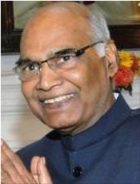Fact Box: Ram Nath Kovind
Bihar Governor Ram Nath Kovind has been chosen by the National Democratic Alliance as its Presidential Candidate.
Facts
The 71-year-old lawyer turned politician Ram Nath Kovind is a commerce graduate and LLB from the Kanpur University in Uttar Pradesh. Kovind practised law in Delhi High Court and the Supreme Court for 16 years. He practised in the Delhi high court from 1977 to 1979 and became an Advocate-on-Record of the Supreme Court of India in 1978. He was also the central government’s standing counsel in the Supreme Court from 1980 to 1993. Kovind stepped into politics in 1984 after elected to Rajya Sabha from Uttar Pradesh. He had served for two consecutive terms till March 2006. During his parliamentary tenure,
Kovind stepped into politics in 1984 after elected to Rajya Sabha from Uttar Pradesh. He had served for two consecutive terms till March 2006. During his parliamentary tenure, Kovind has served in several parliamentary committees including the Parliamentary Committee on Welfare of Scheduled Castes/Tribes, Parliamentary Committee on Social Justice and Empowerment, among others.
Kovind has represented India in the United Nations and addressed United Nations General Assembly in October, 2002.
On August 8, 2015, Kovind was appointed as the governor of Bihar. He had also served as the member of the Board of Management of Dr. B.R Ambedkar University, Lucknow and the Board of Governors of Indian Institute of Management, Kolkata.
Presidential Election-Facts
For the election of the President, the electoral college comprises of the elected members of both Houses of Parliament and elected members of the legislative assemblies of all states, besides Delhi and Puducherry. In a total, 4,896 voters will vote in the election.
Nominated members of the Rajya Sabha, Lok Sabha and legislative assemblies will not have voting rights in the presidential election.
Polling for Presidential elections will take place in Parliament House and on the premises of legislative assemblies. The election shall be by secret ballot.
For the presidential elections, political parties cannot issue any whip to their MPs and MLAs.
The nomination paper of a candidate has to be subscribed by at least 50 electors as proposers and another 50 electors as seconders.
MPs and MLAs do not have one vote each but their votes are equal to the average number of people they represent. Since MPs represent the whole country they have more votes, and MLAs have fewer votes than MPs as they represent only the people in their states. This is called “proportional representation”.
The president is elected for a term of 5 years. He may terminate his own term by writing a resignation addressed to Vice President. He can be removed from the office ONLY by impeachment. He is eligible to re-elected for the same office for unlimited times.
Month: Current Affairs - June, 2017


